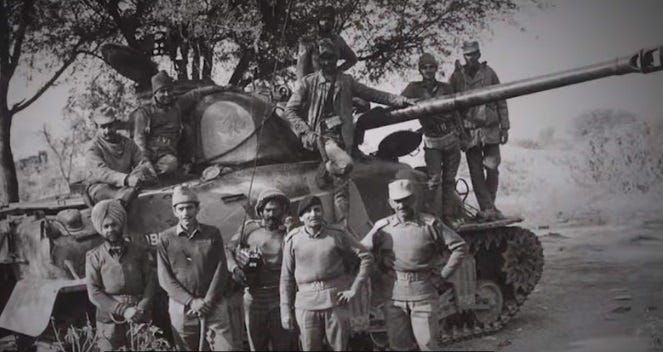This is the first in a series of posts titled Bharat Bravehearts, which takes a look at our Indian Armed forces and some great victories they pulled off over the decades starting with 1947. In the first of the series we take a look at the the Thambi Brigade who played a crucial role during the Battle of Basantar in 1971. It was the 9th Engineer Regiment, so nicknamed as it was mostly staffed by Tamilians then.
Basantar fought over 12 days, was one of the major tank battles post WWII. It was one of the hardest fought battles, with both sides sustaining casualties, and one of the toughest resistance by the Pakistani Army.2 Param Vir Chakras, 4 Maha Vir Chakras, and 4 Vir Chakras were awarded of which 5 were posthmous. The battle had many heroes like Lt. Arun Khetarpal, Major Hoshiar Singh, Major Vijay Rattan Chaudhary, Lt. Col.V.P.Ghai, Capt R.N.Gupta.
“After overcoming the initial shock of the death of our gallant officers and junior commissioned officers, the Thambis’morale is high and we are prepared to breach more Basantars.”
Amidst all those heroes, there was one group, whose contribution was somewhat overlooked, the Thambi Brigade or the 9th Engineer Regiment.The regiment had 3 field companies each of which were assigned to the 3 infantry brigades of the 54 Infantry division. It had the challenging task of laying the operational track, for the Indian army, through some absolutely tough terrain and an area that was heavily mined.
Now in battle, the role of the engineers is as important as that of the soldiers and generals. They are the ones who lay the tracks, build briddges over rivers for tanks to cross, and they have to do it often under heavy fire, and mines all around.
The 9th Engineer Regiment's CO was Lt. Col B.T.Pandit who supervised the entire operation of laying the tracks, and was awarded the Vir Chakra later. 2nd Lt NP Singh, started laying the track on December 5, 1971 at 7:30 PM, within 2 hours they were in Pakistani territory.
By December 6, the track was completed up to Badala Gujran in Pakistan and on December 7, a 600 m long, 6 m wide track was laid out in conjunction with the 47 Infantry Brigade.
December 8- 404 Field Company, was given task of providing support to the 91 Infantry Brigade, while 405 did the same for 16 Armored Brigade, while 406 extended the track beyond Tarakwal.
December 9-404 Field Company, was marked for 76 Infantry, and the operational track was connected to Bari.
December 10/11- Naik Subedar Doraiswamy, who had the task of clearing the minefields, found the path blocked by a damaged Indian tank. Taking an initiative, Doraiswamy, led a small unit through heavy Pakistani artillery barrage and succeeded in creating a detour, that enabled the Indian armor and artillery to move to the bridgehead. He was later awarded the Vir Chakra for this.
December 11- Diversion was created on the Mawa-Pandgaur road for free movement of vehicles, while 405 also cleared the minefield lane on December 12, and on December 13 it breached an enemy minefield with 1300 m deep trawls upto Lohara.
December 15- Engineering Task Force comprising the 3 units was grouped with 47 Infantry Brigade for crossing the Basantar River at Lagwal.This was the toughest part of the assignment, an operational track had to be constructed from Lohara to Lagwal, the enemy minefield had to be breached, and crossing places had to be constructed on two marshy nullahs.
The work started at 8 PM under heavy artillery fire from the Pakistani side.Major Vijay Rattan Chaudhary, heading the Task force, had to breach the minefield, and make the passage for tanks and other armored vehicles through the Basantar river.However the intense shelling and lack of information about the obstacles, threw the unit into confusion. With not much time for reconnaisance, the CO, decided to send a small unit, pretty much a risky proposition.
December 16- 2 companies of 17 Poona Horse, took on the enemy’s counter attacks, and destroyed the armored formation, on the west bank.
Captain Ravinder Nath Gupta volunteered for this hazardous mission. Braving enemy fire, he managed to bring back vital information by 9:30 PM. Guiding the tanks, through the cleared minefield lane, he was killed in action along with Major Vijay Chaudhary, S.S.Mallik and 2nd Lt K.M.Mandanna.
The ceasefire was called for on December 17 at 8 PM. For their heroic exploits, the Regiment was called the Basantar Regiment, given the battle honor Basantar and Theater Honor of Punjab.





Nicely penned and historically accurate. Please keep writing and I look forward to more in this series. Restacking..
Felt very nostalgic about living with Thambis the 17 Madras and their week end Dosa party at the Field Mess . The story of this Engineer Regt . Is glorious chapter of our Military . Reading about the death of some heroes choked me .